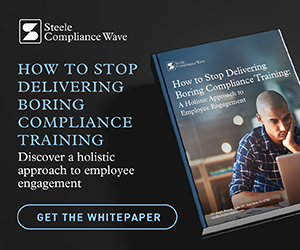 Even the most conscientious employee may struggle to stay awake during a 40-minute e-learning session on your company’s bribery policy – especially on a Friday afternoon, right after lunch. It’s no wonder why many compliance professionals are adding video to their compliance resources.
Even the most conscientious employee may struggle to stay awake during a 40-minute e-learning session on your company’s bribery policy – especially on a Friday afternoon, right after lunch. It’s no wonder why many compliance professionals are adding video to their compliance resources.
Videos that merely distract or entertain employees, however, probably won’t accomplish much in terms of creating a culture of compliant behavior. In this article, we’ll explore why video works, and when and how you should use it.
What Makes Videos Effective As Compliance Communication Tools?
Here are just a few of the advantages of using videos as part of your compliance communication plan:
1. Creating An Emotionally Resonant Experience
Video allows you to shape the audience’s emotional engagement, using music, pacing and other techniques. This type of emotional experience makes compliance resources more effective.
Take, for example, a compliance video in which a narrator’s friendly voice asks, “Have you ever been in a difficult situation where …” This invitation to empathize helps to align the audience with the video’s narrator and – by extension – the compliance officer who has asked them to view it. Next, the video shows a scenario that’s broadly applicable and that asks employees to imagine themselves in it, which arouses some degree of anxiety. Finally, the video shows how to resolve that anxiety by taking the proper steps to address the compliance issue. By the end of a short video, employees feel like they’ve gone through a challenging situation, learned what to do and reaped the emotional rewards of following the route of compliance.
2. Showing Instead Of Telling
For literally millennia, text has proven a highly effective tool for conveying information, instructions and the whole range of human emotion. But, as any good English teacher would tell you, text that seeks to communicate by telling rather than showing is far less engaging, especially on an emotional level. Most compliance-related writing relies heavily on this “telling” approach, so it remains abstract, cold and distant.
Video’s plasticity as a medium provides greater opportunities to illustrate and show scenarios, which is particularly helpful when addressing more abstract compliance issues. This ability to show often makes compliance issues more concrete and relatable for employees, increasing their emotional engagement and receptivity.
3. Maximizing Attention
Compared to sitting through a dense PowerPoint presentation, people expect videos to be fairly brief and slick, so they’re less likely to tune out. When someone is able to see that a video runs only four minutes, they’re more willing to reserve their upfront objections and judgments – which maximizes their attention to the topic at hand.
Why Videos Alone Aren’t Enough
Even with the advantages that videos offer, they’re probably not very effective in a standalone capacity. One drawback to videos, for example, is their lack of interactivity. To get the best results, videos should be part of a broader, holistic compliance communication program. Behavior-change science suggests that an effective program should include as many different modalities as you’re able to reasonably manage.
While the concept of people having different “learning styles” is somewhat controversial at present, a multimedia, multi-modal communication plan does provide more opportunities for learning and retaining compliance information. Multiple channels allow you to put low-bandwidth, non-intrusive messages in front of people on a consistent basis. This approach is highly effective in building awareness, as we know from successful advertising campaigns.
In addition, communicating with employees in a variety of formats gives you more opportunities to disrupt their expectations for any given format. These “pattern interrupts” serve as effective behavior-change tools: A person expects one thing but gets something else, and that makes them more conscious and more apt to learn something.
Changing The Dynamics In Compliance Communication
If your current compliance resources just aren’t getting through to bored, defensive and disengaged audience members, consider using videos as part of your communication plan. A well-designed video uses language, music cues and a narrative arc to create an emotional experience: The viewer experiences the negative feelings associated with following the wrong path, and learns to associate compliance with feelings of happiness and success.
Such an approach also changes the dynamics of compliance conversations: moving away from an adversarial tone that demands a certain outcome, and toward an empowering tone that encourages a certain outcome. The end result is a wider, more receptive audience – and compliance resources that don’t put your employees to sleep.




